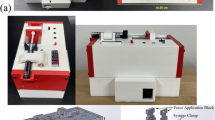Abstract
An impeller the same geometry as the impeller of a commercial monopivot cardiopulmonary bypass pump was manufactured using 3D printing. The 3D-printed impeller was integrated into the pump casing of the commercially available pump to form a 3D-printed pump model. The surface roughness of the impeller, the hydraulic performance, the axial displacement of the rotating impeller, and the hemolytic properties of the 3D-printed model were measured and compared with those of the commercially available model. Although the surface roughness of the 3D-printed model was significantly larger than that of the commercially available model, the hydraulic performance of the two models almost coincided. The hemolysis level of the 3D-printed model roughly coincided with that of the commercially available model under low-pressure head conditions, but increased greatly under high-pressure head conditions, as a result of the narrow gap between the rotating impeller and the pump casing. The gap became narrow under high-pressure head conditions, because the axial thrust applied to the impeller increased with increasing impeller rotational speed. Moreover, the axial displacement of the rotating impeller was twice that of the commercially available model, confirming that the elastic deformation of the 3D-printed impeller was larger than that of the commercially available impeller. These results suggest that trial models manufactured by 3D printing can reproduce the hydraulic performance of the commercial product. However, both the surface roughness and the deformation of the trial models must be considered to precisely evaluate the hemolytic properties of the model.






Similar content being viewed by others
References
Standard terminology for additive manufacturing technologies, ASTM Standard F2792-12a, 2012.
Golding L, Smith W, Horvath D, Medvedev A. Rotodynamic pump development. In: Matsuda H, editor. Rotary blood pumps. Springer-Verlag: Tokyo; 2000. p. 47–56.
Bourque K, Gernes DB, Loree HM II, Richardson JS, Poirier VL, Barletta N, Fleischli A, Foiera G, Gempp TM, Schoeb R, Litwak KN, Akimoto T, Watach ML, Litwak P. HeartMate III: pump design for a centrifugal LVAD with a magnetically levitated rotor. ASAIO J. 2001;47:401–5.
Chan WK, Wong YW, Chua CK, Lee CW, Feng C. Rapid manufacturing techniques in the development of an axial blood pump impeller. Proc Inst Mech Eng H. 2003;217:469–75.
Rajenthirakumar D, Jagadeesh KA. Analysis of interaction between geometry and efficiency of impeller pump using rapid prototyping. Int J Adv Manuf Tech. 2009;44:890–9.
Throckmorton AL, Kapadia JY, Chopski SG, Bhavsar SS, Moskowitz WB, Gullquist SD, Gangemi JJ, Haggerty CM, Yoganathan AP. Numerical, hydraulic, and hemolytic evaluation of an intravascular axial flow blood pump to mechanically support Fontan patients. Ann Biomed Eng. 2011;39:324–36.
Gregory SD, Loechel N, Pearcy MJ, Fraser J, Parnis S, Cohn WE, Timms D. Anatomic fitting of total artificial hearts for in vivo evaluation. Artif Organs. 2013;37:735–41.
Leme J, da Silva C, Fonseca J, da Silva BU, Uebelhart B, Biscegli JF, Andrade A. Centrifugal blood pump for temporary ventricular assist devices with low priming and ceramic bearings. Artif Organs. 2013;37:942–5.
Nishida M, Maruyama O, Kosaka R, Yamane T, Kogure H, Kawamura H, Yamamoto Y, Kuwana K, Sankai Y, Tsutsui T. Hemocompatibility evaluation with experimental and computational fluid dynamic analyses for a monopivot circulatory assist pump. Artif Organs. 2009;33:378–86.
Yamane T, Kosaka R, Nishida M, Maruyama O, Yamamoto Y, Kuwana K, Kawamura H, Shiraishi Y, Yambe T, Sankai Y, Tsutsui T. Enhancement of hemocompatibility of the MERA monopivot centrifugal pump: toward medium-term use. Artif Organs. 2013;37:217–21.
Nishida M, Nakayama K, Sakota D, Kosaka R, Maruyama O, Kawaguchi Y, Kuwana K, Yamane T. Effect of impeller geometry on lift-off characteristics and rotational attitude in a monopivot circulatory pump. Artif Organs. 2016;40:E89–101.
Naito K, Mizuguchi K, Nose Y. The need for standardizing the index of hemolysis. Artif Organs. 1994;18:7–10.
Moody LF. Friction factors for pipe flow. Trans ASME. 1944;66:671–84.
Takami Y, Nakazawa T, Makinouchi K, Glueck J, Benkowski R, Nosé Y. Effect of surface roughness on hemolysis in a centrifugal blood pump. ASAIO J. 1996;42:M858–62.
Umezu M, Yamada T, Fujimasu H, Fujimoto T, Ranawake M, Nogawa A, Kijima T. Effect of surface roughness on mechanical hemolysis. Artif Organs. 1996;20:575–8.
Maruyama O, Nishida M, Yamane T, Oshima I, Adachi Y, Masuzawa T. Hemolysis resulting from surface roughness under shear flow conditions using a rotational shear stressor. Artif Organs. 2006;30:365–70.
Acknowledgments
The authors would like to thank Mr. Keiichi Higuchi from Hiyama Industry, Co., Ltd., and Mr. Hiroshi Yamashita from the Industrial Technology Institute of Ibaraki Prefecture for providing planning, technical support for 3D printing, and surface roughness measurements.
Author information
Authors and Affiliations
Corresponding author
Ethics declarations
Conflict of interest
Masahiro Nishida received research funding from Senko Medical Instrument Manufacturing, Co., Ltd. Katsuyuki Kuwana is the employee of Senko Medical Instrument manufacturing, Co., Ltd. The other authors declare that they have no conflicts of interest.
Rights and permissions
About this article
Cite this article
Nishida, M., Negishi, T., Sakota, D. et al. Properties of a monopivot centrifugal blood pump manufactured by 3D printing. J Artif Organs 19, 322–329 (2016). https://doi.org/10.1007/s10047-016-0914-9
Received:
Accepted:
Published:
Issue Date:
DOI: https://doi.org/10.1007/s10047-016-0914-9




